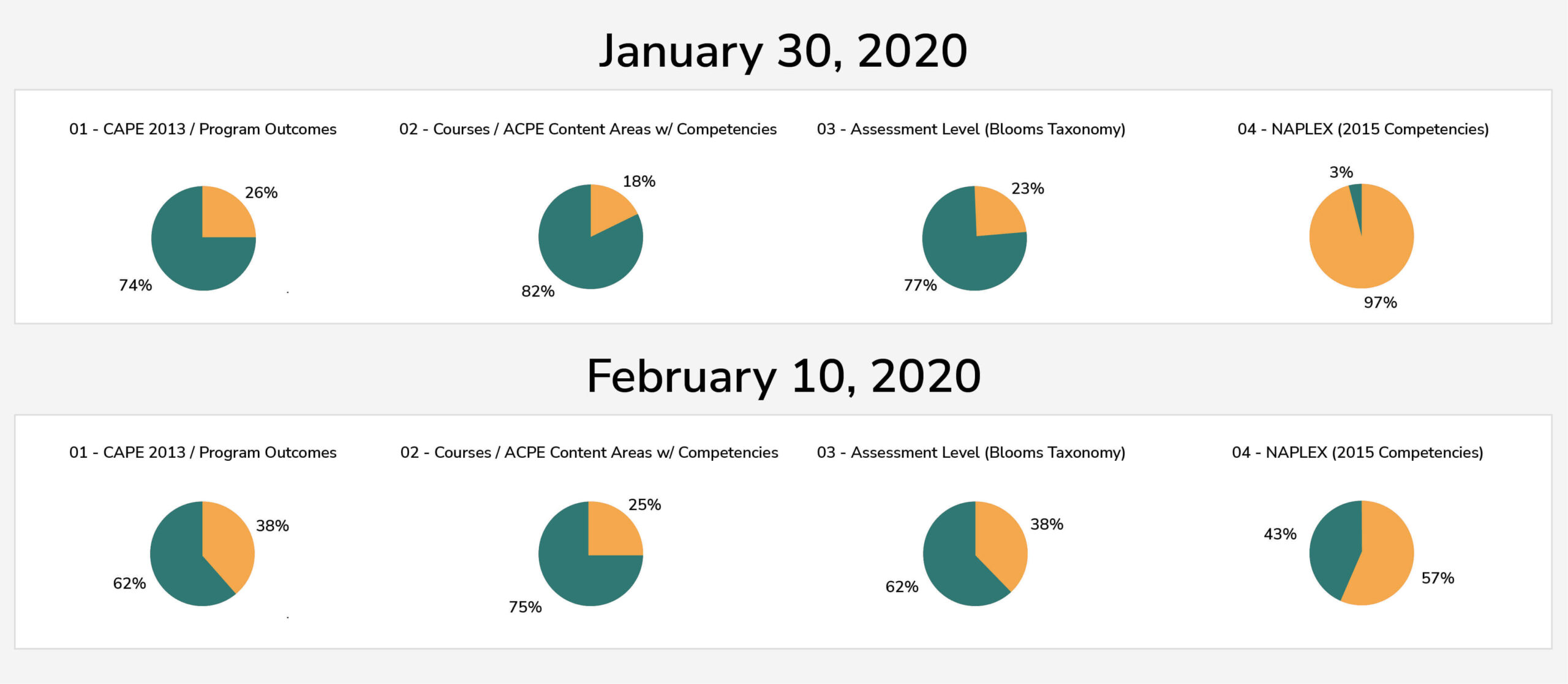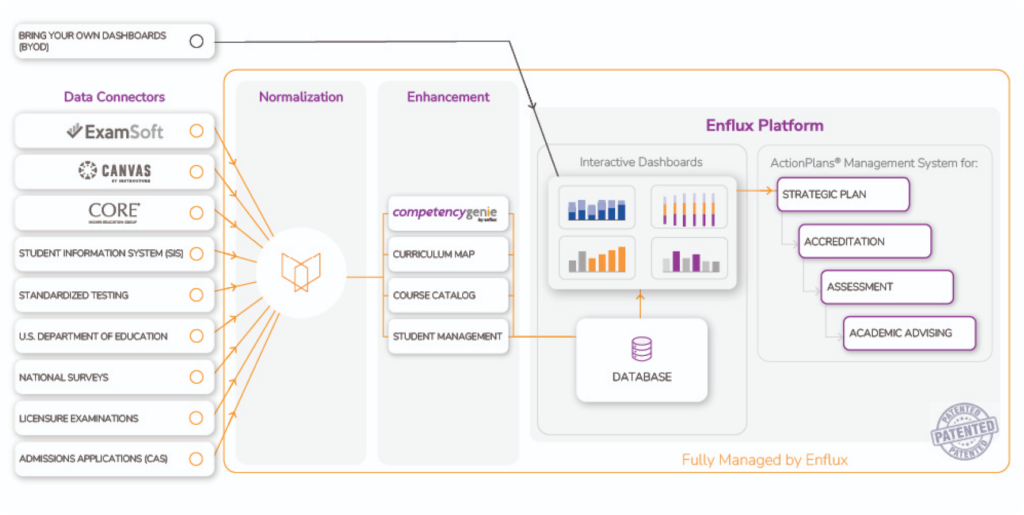Share links
Home › Case Studies › Florida A&M Case Study
Case Study
How Florida A&M University Achieved 100% Faculty Compliance with Enflux
This case study explores the implementation of Enflux’s data analytics and decision support platform at Florida A&M University’s College of Pharmacy, leading to improved faculty compliance and student exam pass rates.
August 19, 2024 · 7 min read


Florida A&M University
Florida A&M University’s College of Pharmacy has been a leader in pharmacy education since its inception. Serving a diverse student population, the college is committed to providing comprehensive education and training to future pharmacists.
School type
College of Pharmacy
Location
Tallahassee, Florida
Website
LMS integration
- ExamSoft
- Canvas
Enflux product(s)
- EDU (ExamSoft) Suite
- Canvas Monitoring Suite
- ACPE Monitoring Suite
- IPEDS Peer Report
- Institutional Effectiveness Plans
- ActionPlans® Management System
Overview
Florida A&M University’s College of Pharmacy faced significant challenges in improving student outcomes, particularly concerning the NAPLEX exam pass rates. After noticing a sharp decline in student performance, the administration sought a comprehensive solution to revamp their curriculum and data management processes. In October 2019, the college implemented Enflux’s Academic Intelligence platform, which provided real-time insights through intuitive dashboards. This implementation enabled the faculty to achieve 100% compliance in exam tagging, streamline accreditation reporting, and ultimately improve NAPLEX pass rates. The solution not only met the immediate needs of the college but also provided a framework for continuous improvement in academic performance and curriculum effectiveness.
Challenge
In 2016, Florida A&M’s pharmacy school noted a 26% decline in student passing rates on the NAPLEX exam, drawing administration and faculty attention. To reverse the trend and improve accreditation compliance, the school set out to strengthen its curriculum.
The college identified several critical areas that required immediate attention:
- Automated data extraction: Faculty needed a more efficient way to extract, analyze, and organize program performance data at the student level to identify gaps and areas for improvement.
- Tagging compliance: Ensuring that every professor tagged exam questions to the correct CAPE, ACPE, Blooms, and NAPLEX categories was essential for accurate curriculum assessment.
- Prioritization of opportunities: The school needed a system to prioritize and address areas of opportunity quickly to increase operational efficiency and effectiveness.
- Centralized reporting: Faculty members were overburdened with manual reporting processes, and there was a lack of a centralized system to compile and share actionable insights.
“We needed to make decisions and take action early in the semester instead of waiting until finals when students might possibly be failing, and then try to figure out what, if anything, we could do. But, as with most schools, our faculty were already extremely busy and didn’t always have time to run ExamSoft reports. Even when they did, those reports didn’t compile results in a centralized place.”
Florida A&M’s Executive Director of IT

The challenge was further compounded by the faculty’s already heavy workload, which made it difficult for them to manually run ExamSoft reports and compile results from disparate sources. The school’s Executive Director of Information Technology recognized the need for a solution that could streamline these processes and provide faculty with real-time data to make informed decisions early in the semester, rather than reacting to issues at the end of the term.
Solution
In October 2019, Florida A&M University’s College of Pharmacy participated in a demonstration of Enflux’s capabilities. The solution immediately stood out to the Executive Director of IT due to its comprehensive dashboards that could display all the necessary information for tracking faculty compliance and student performance.
“I liked the product immediately because it can display on dashboards all the information we need to track.”
Florida A&M’s Executive Director of IT

Upon deciding to implement Enflux, the college quickly moved forward with the integration. The Enflux Customer Success Team worked closely with Florida A&M to understand their unique needs and environment. Within a week, the necessary code was written, and the college’s ExamSoft data was seamlessly migrated into Enflux, populating the dashboards automatically.

“From signing the contract to having our faculty trained and ready to go, took less than a month.”
Florida A&M’s Executive Director of IT

The college’s faculty was trained on-site in November, and within less than a month from signing the contract, the entire system was up and running. The Enflux platform’s Categories Per Item dashboard revealed that a significant portion of the faculty (73%) had not tagged all of their exam questions. Enflux dashboards further revealed compliance in each of four tagging categories: 74% for CAPE, 82% for ACPE, 77% for Blooms, and 3% for NAPLEX. With this insight, the administration set a deadline for 100% compliance, and weekly ActionPlans® were generated to monitor progress.
Enflux’s real-time data dashboards empowered faculty to make immediate adjustments, and the use of the platform revealed critical insights, such as the misperception that NAPLEX tags were not applicable to certain course materials. This led to targeted faculty training and a significant increase in NAPLEX tagging compliance.
“Good data produces good insights and the ability to make good decisions. Having categories tagged correctly was critically important to achieving our goal of improving student’s NAPLEX first-time pass rate.”
Florida A&M’s Executive Director of IT

As the February 28, 2020 deadline approached, the Enflux team provided additional support by updating dashboards more frequently and assisting with custom reporting. The Dean also implemented recognition initiatives to incentivize faculty compliance, further driving the college toward its goals.

Student Performance Dashboard and Customer Support
In addition to tagging, the Student Performance Dashboard played a crucial role in improving exam scores. By providing detailed insights into individual student performance, faculty could identify at-risk students early and intervene with targeted support (e.g., mentoring, requesting separate study sessions with the professor on a specific topic, after-hours videoconference meetings, tutoring). This proactive approach helped students improve their scores significantly, as illustrated by a student who raised his exam score from 66.5 to 84 after receiving additional support.
Throughout the implementation, Enflux’s Customer Success and Development teams provided agile support, addressing the college’s unique needs quickly and effectively. This customer-driven approach ensured that Enflux met all of Florida A&M’s requirements, contributing to the overall success of the implementation.

Results

100% tagging compliance

streamlined ACPE reporting

improved NAPLEX scores

proactive student intervention
- After just one month of implementing Enflux, Florida A&M’s College of Pharmacy achieved 100% compliance in tagging exam questions across all four targeted categories—CAPE, ACPE, Blooms, and NAPLEX. This ensured accurate curriculum assessment and alignment with accreditation standards
- The college now uses Enflux for documentation and ACPE reports, centralizing data collection and simplifying what was once a complex process. “We used to have to pull self-study information from a number of disparate sources,” said Florida A&M’s Executive Director of IT. “Now, we use Enflux to pull all our information from a centralized source.”
- Based on insights from Enflux dashboards, Florida A&M produces reports for ACPE that detail the school’s compliance plans and efforts to enhance NAPLEX scores. This has contributed to an increase in first-time NAPLEX pass rates, which now range between 87% to 92%.
- By utilizing Enflux as an early-alert system for intervention and remediation, the college is able to identify at-risk students after their first exams. This proactive approach enables data-driven decisions and supports student success, reinforcing confidence in the outcomes.
Share this case study with your colleagues to explore strategies for enhancing academic success within your program

Discover how Enflux can transform your decision-making process and drive your program’s success
